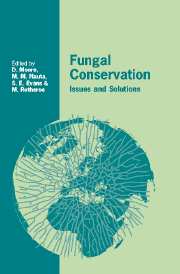Book contents
- Frontmatter
- Contents
- List of contributors
- Preface
- 1 Fungal conservation issues: recognising the problem, finding solutions
- 2 Current trends and perspectives for the global conservation of fungi
- 3 Conservation and management of forest fungi in the Pacific Northwestern United States: an integrated ecosystem approach
- 4 The future of fungi in Europe: threats, conservation and management
- 5 Fungi as indicators of primeval and old-growth forests deserving protection
- 6 Recognising and managing mycologically valuable sites in The Netherlands
- 7 Threats to hypogeous fungi
- 8 Wild mushrooms and rural economies
- 9 Threats to biodiversity caused by traditional mushroom cultivation technology in China
- 10 A preliminary survey of waxcap grassland indicator species in South Wales
- 11 Grasslands in the coastal dunes: the effect of nature management on the mycota
- 12 The conservation of fungi on reserves managed by the Royal Society for the Protection of Birds (RSPB)
- 13 Strategies for conservation of fungi in the Madonie Park, North Sicily
- 14 Fungal conservation in Ukraine
- 15 The threatened and near-threatened Aphyllophorales of Finland
- 16 Fungal conservation in Cuba
- 17 Microfungus diversity and the conservation agenda in Kenya
- 18 Fungi and the UK Biodiversity Action Plan: the process explained
- 19 The Scottish Wild Mushroom Forum
- 20 The contribution of national mycological societies: establishing a British Mycological Society policy
- 21 The contribution of national mycological societies: the Dutch Mycological Society and its Committee for Fungi and Nature Conservation
- 22 Fungal conservation in the 21st century: optimism and pessimism for the future
- Index
11 - Grasslands in the coastal dunes: the effect of nature management on the mycota
Published online by Cambridge University Press: 13 October 2009
- Frontmatter
- Contents
- List of contributors
- Preface
- 1 Fungal conservation issues: recognising the problem, finding solutions
- 2 Current trends and perspectives for the global conservation of fungi
- 3 Conservation and management of forest fungi in the Pacific Northwestern United States: an integrated ecosystem approach
- 4 The future of fungi in Europe: threats, conservation and management
- 5 Fungi as indicators of primeval and old-growth forests deserving protection
- 6 Recognising and managing mycologically valuable sites in The Netherlands
- 7 Threats to hypogeous fungi
- 8 Wild mushrooms and rural economies
- 9 Threats to biodiversity caused by traditional mushroom cultivation technology in China
- 10 A preliminary survey of waxcap grassland indicator species in South Wales
- 11 Grasslands in the coastal dunes: the effect of nature management on the mycota
- 12 The conservation of fungi on reserves managed by the Royal Society for the Protection of Birds (RSPB)
- 13 Strategies for conservation of fungi in the Madonie Park, North Sicily
- 14 Fungal conservation in Ukraine
- 15 The threatened and near-threatened Aphyllophorales of Finland
- 16 Fungal conservation in Cuba
- 17 Microfungus diversity and the conservation agenda in Kenya
- 18 Fungi and the UK Biodiversity Action Plan: the process explained
- 19 The Scottish Wild Mushroom Forum
- 20 The contribution of national mycological societies: establishing a British Mycological Society policy
- 21 The contribution of national mycological societies: the Dutch Mycological Society and its Committee for Fungi and Nature Conservation
- 22 Fungal conservation in the 21st century: optimism and pessimism for the future
- Index
Summary
Introduction
Many regions of the dunes along the coast of The Netherlands are now in use as part of the drinking water supply chain and are therefore well protected. The Amsterdam Waterworks Dunes, situated south and west of Haarlem, deliver drinking water to the city of Amsterdam. The site is owned and managed by the municipality of Amsterdam. In this dune field of 34 km2 the mycota of two, locally decalcified, natural grasslands has been studied since 1986 (Becker & Baeyens, 1992; Nauta & Jalink, 1996). The management consists of summer grazing by cattle in one site (Eiland van Rolvers), and yearly mowing and removal of the hay in the other (Groot Zwarteveld).
History
The area of the Amsterdam Waterworks Dunes consists mainly of young dunes, formed during several periods of blowing sand from the eleventh century onwards. The soils differ in calcium content, depending on the period in which they were formed, and this can often be seen from the vegetation. For instance, the Hippophae rhamnoides scrub, developed in the central part of the Amsterdam Waterworks Dunes from around 1500–1600 onwards, has usually developed on more or less calcareous soil. From early days humans have used the dunes. There is evidence that from 1500 onwards, wet dune slacks have been grazed in summer by cattle and sheep.
In the early nineteenth century the dune area also became popular for growing potatoes.
- Type
- Chapter
- Information
- Fungal ConservationIssues and Solutions, pp. 136 - 143Publisher: Cambridge University PressPrint publication year: 2001
- 2
- Cited by



